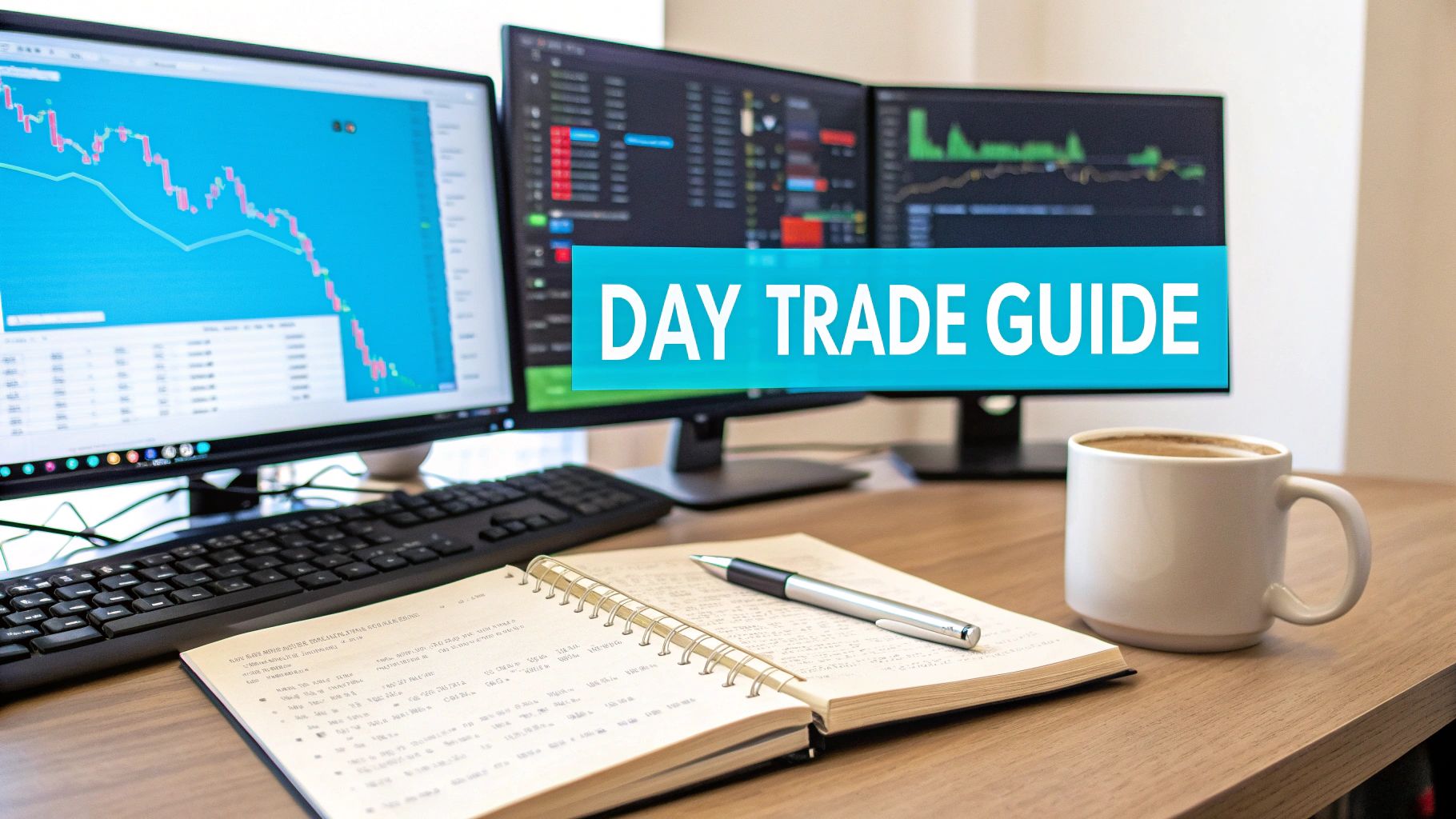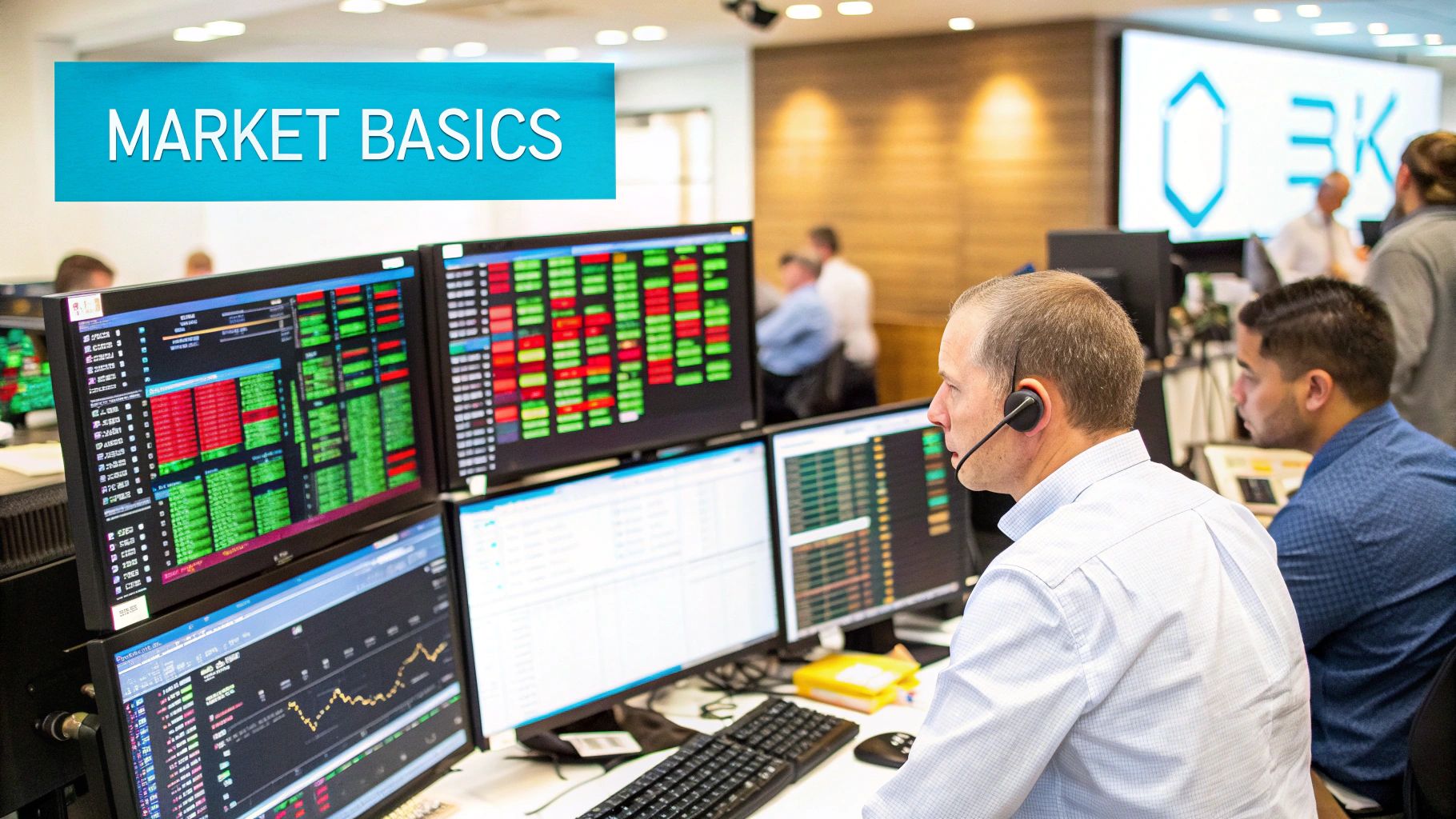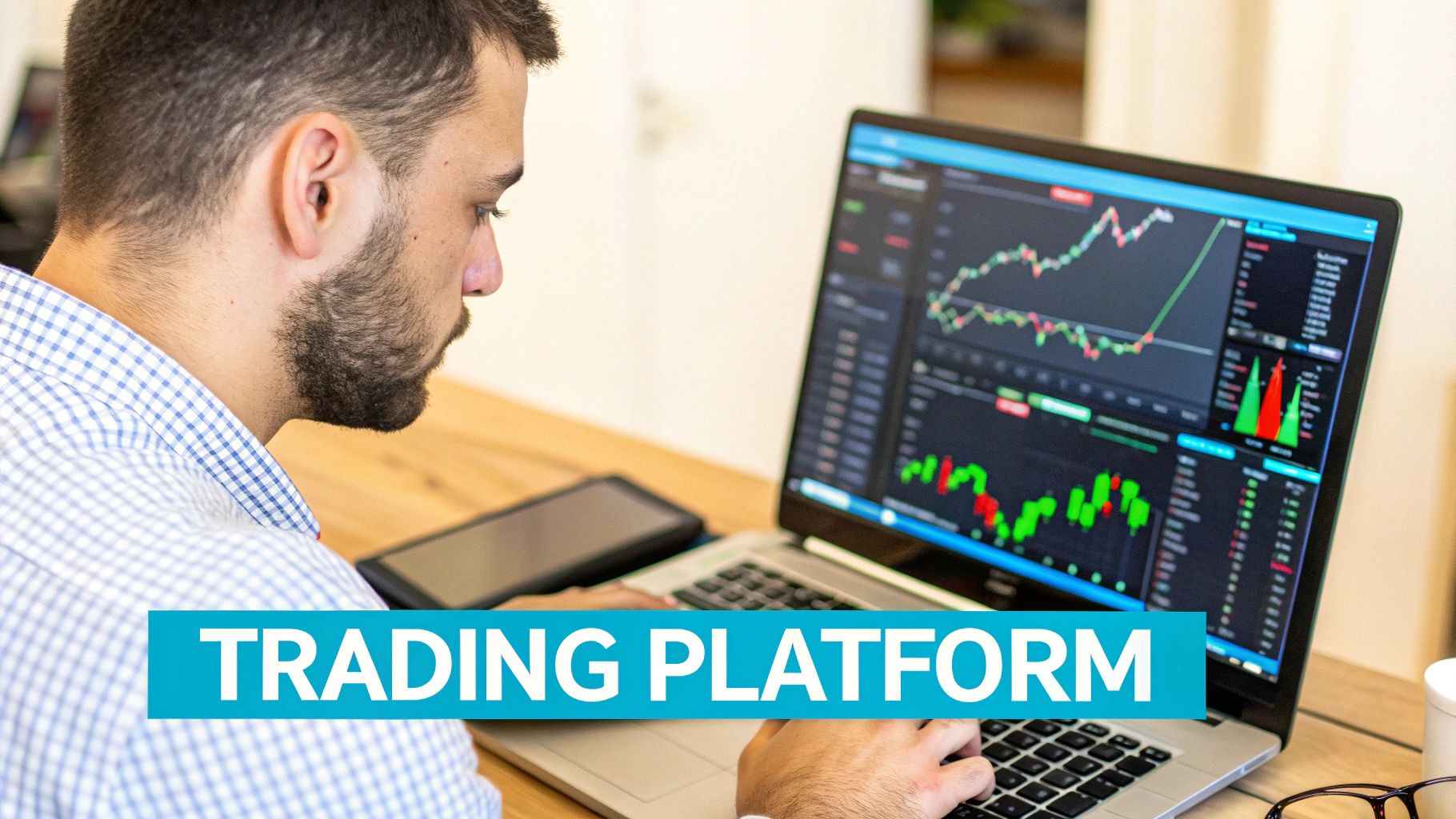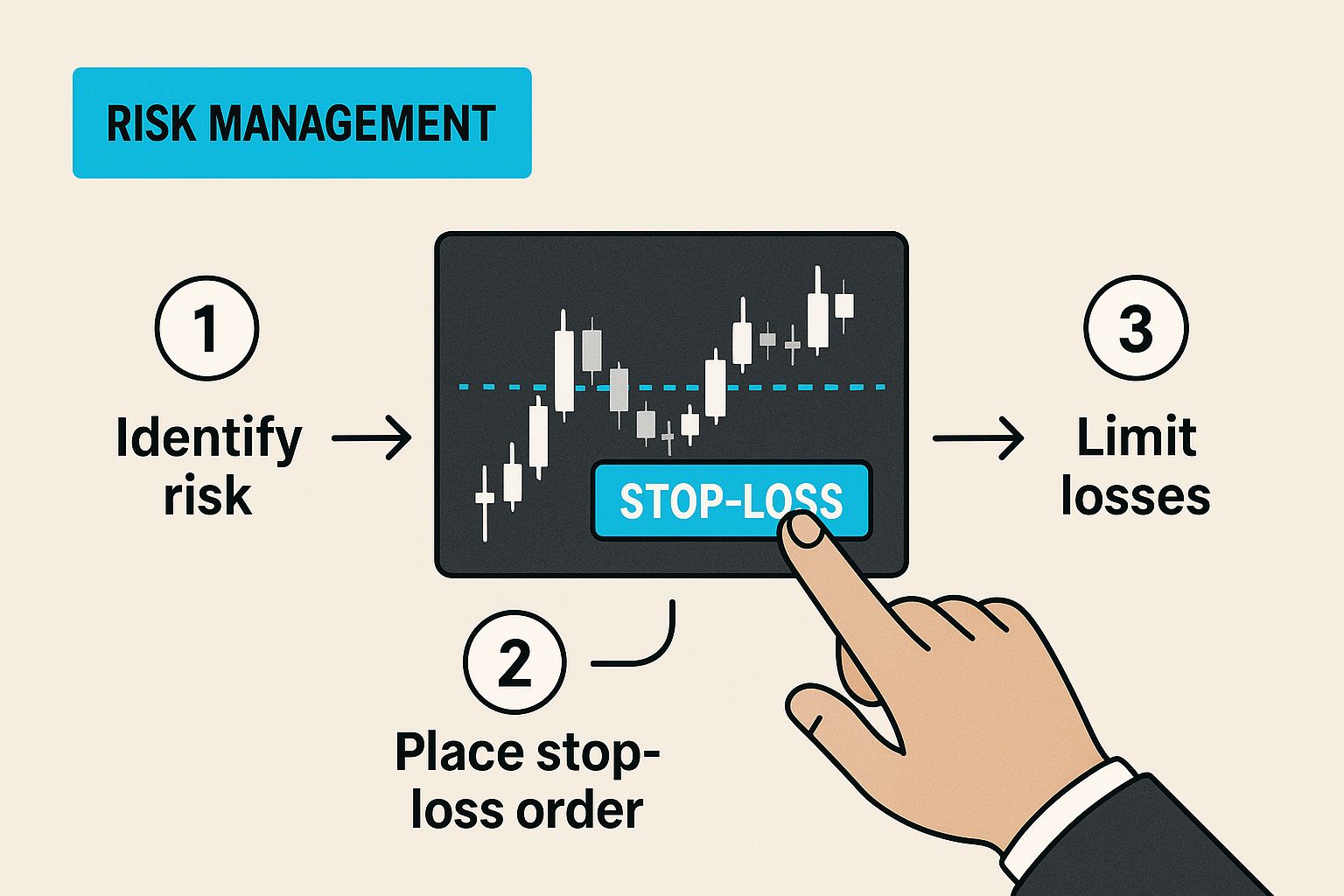




Alright, let's get one thing straight before you even think about placing your first trade. Day trading isn't a get-rich-quick scheme. It’s a high-performance profession, and if you treat it like anything less, the market will chew you up and spit you out. Your journey starts with a solid education, a strict set of rules, and an unwavering commitment to getting better every single day.
This is a serious business that demands real discipline and a healthy respect for how the markets work.

Before we dive into the "how-to," we need to have a frank conversation about what you're getting into. Forget the social media hype showing flashy cars and effortless profits. That's not the reality. The real world of day trading is an intense, competitive arena that tests your character, patience, and emotional control more than anything else.
The market is an expensive place to find out who you really are. Every click of the mouse reveals your relationship with fear and greed. If you're impulsive or impatient, the market will find that weakness and exploit it. This is exactly why so many aspiring traders fail—they completely underestimate the mental game.
Day trading is the best and most expensive self-development program you will ever enroll in. It forces you to look inward at your habits and your own emotions and character. To succeed, you must be brutally honest with yourself.
The numbers don't lie, and they paint a pretty sobering picture. Research consistently shows that only about 13% of day traders manage to stay profitable over a six-month period. Stretch that out to five years, and the number drops to a mere 1%. You can dig into the details of these day trading statistics, but the takeaway is clear: this is hard.
I'm not telling you this to scare you off. I'm telling you this to ground you in reality. The traders who make it are the ones who treat this as a serious business from the very beginning. They put in hundreds of hours learning and practicing before ever putting real money on the line.
Beyond the mental game, there are two technical concepts you absolutely must understand: liquidity and volume. These aren't just textbook terms; they directly impact your ability to execute your strategy and manage your risk.
For a day trader, these are your lifeblood. If you try to trade something with low liquidity and low volume, you can get stuck. You might hit the "sell" button, but there's no one on the other side to buy from you at your price. This leads to slippage, where your order gets filled at a much worse price than you intended, turning a small, manageable loss into a big, painful one.
Before you jump in, it's crucial to internalize a few core truths. I've broken down the most important ones here.
Grasping these ideas is your first real step. It shifts your mindset from "How much can I make today?" to "How do I build the skills to survive and compete tomorrow?" Acknowledging the difficulty of this profession is what separates the gamblers from the serious traders.

Think of your trading setup as your digital command center. Just like a pilot relies on their instruments, you need a dependable broker, fast software, and the right hardware to navigate the markets. Getting this right isn't just a technicality—it’s your first real win as a trader.
This all starts with picking a broker, which is probably the most critical decision you'll make at the outset. This isn't just about chasing the lowest fees. You're handing over your hard-earned capital, so you need a company that's stable, reliable, and trustworthy.
Don't just jump on the first broker with a flashy ad. The right choice really depends on what market you plan to trade, your style, and how much capital you're starting with. Someone trading stocks has completely different needs than a futures trader, especially when you factor in rules like the Pattern Day Trader (PDT) rule in the U.S.
When you're comparing brokers, dig deeper than the marketing promises. Here’s what I always look for:
Once you’ve picked one, funding your account is usually simple, often through a bank transfer (ACH) or wire. The most important advice I can give here is to start with an amount you are 100% prepared to lose. Seriously. Consider it tuition money for your trading education.
Your trading capital is your business inventory. Protecting it is your number one job. Never, ever start with money you need for rent or bills. Your initial goal is just to survive, not to get rich by next Tuesday.
With your account funded, the next step is getting your charting platform dialed in. While most brokers have their own built-in charts, many experienced traders use dedicated software for more advanced tools. TradingView is a massive favorite in the community for a reason—it’s powerful, clean, and packed with features.
This is where you'll live, spending your days analyzing charts and hunting for setups. One of the best features of a platform like TradingView is its ability to connect directly to your broker. This means you can link your TradeStation or Interactive Brokers account and trade straight from your charts.
This integration is a complete game-changer. Instead of fumbling between your beautiful charts and your broker's clunky order window, you can place, move, and cancel orders with a single click on the chart itself. In fast-moving markets, that speed and efficiency are everything.
Finally, let's touch on the physical gear. You don’t need a mission control center worthy of NASA, but a slow computer or a flaky internet connection can lead to some very expensive mistakes.
Treat your hardware as an investment in your trading business. At a bare minimum, you'll want:
Jumping into the market without a plan is a surefire way to burn through your cash. It's what separates professional trading from straight-up gambling. A solid trading strategy is your personal rulebook—it keeps you disciplined when emotions like fear and greed inevitably try to take over the driver's seat.
Your first strategy doesn't need to be some complicated beast. In fact, simple is usually better when you're starting out. The goal is to build a systematic approach based on three core pillars that work together for every single trade.
Think of these as the foundation of your trading career:
This is where the magic happens. We're going to turn a noisy, chaotic price chart into a clear roadmap. Technical indicators are just math formulas based on price and volume data that help us spot trends, momentum, and potential turning points. There are hundreds out there, but your job is to pick just a few that work well together.
This is exactly where a tool like EzAlgo shines. Instead of cluttering up your screen with a dozen different indicators that might contradict each other, EzAlgo distills multiple data points into clean, easy-to-read signals. For instance, a basic entry signal could be as simple as waiting for an EzAlgo "Buy" signal to pop up on your chart.
But one signal alone is rarely enough. The best strategies look for multiple points of confirmation, what traders call "confluence," to stack the odds in their favor.
Let's walk through a real-world example of an entry rule:
When all three of those conditions line up, you have a high-probability setup based on rules, not emotion. That systematic process is what truly separates consistent traders from everyone else. You can dive deeper into combining these tools with our detailed guide to beginner trading strategies, which has plenty more examples.
This might sound backward, but your exit rules are arguably more important than your entry rules. They are your last line of defense for protecting your trading capital.
A stop-loss order is your non-negotiable safety net. It’s a pre-set order that automatically sells your position at a certain price to cap your loss. A great place to set a stop-loss is just below a recent swing low on the chart or at a key support level that EzAlgo's automated levels can help you identify.
A take-profit order is how you lock in your wins. A simple and effective method is to aim for a specific risk-to-reward ratio. For example, if you're risking $50 on a trade (the distance from your entry to your stop-loss), you could set your take-profit at a point where you'd make $100. That's a solid 2:1 risk-to-reward ratio.
Lastly, you have to figure out your position size. The gold standard here is the 1% Rule, a cornerstone of risk management. It’s simple: never risk more than 1% of your total account balance on a single trade.
If you have a $5,000 account, your maximum risk on any one trade should be just $50. This discipline ensures that even a string of losses won't knock you out of the game, giving you the breathing room you need to learn and adapt.
This image perfectly illustrates why setting your risk parameters before you enter is so crucial.

As you can see, managing risk with a tool like a stop-loss isn't just an afterthought—it's a core part of the trade setup itself. Think of your strategy as your business plan. Write it down, test it, refine it, and then follow it without hesitation. This rule-based approach will be your greatest asset as you learn how to start day trading.
Let's talk about the single most important skill in trading. It’s not about finding brilliant entries or predicting the market’s next move. It’s about managing risk. This is the unglamorous, disciplined work that separates the pros from the 90% of traders who ultimately fail.
Your number one job isn't to make money—it's to protect the capital you already have. Think of it this way: effective risk management keeps you in the game long enough to learn, adapt, and eventually find your edge. It's a non-negotiable set of rules ensuring no single trade, or even a string of bad ones, can knock you out of the market for good.
The market is a professional risk-taker's environment. If you don't manage your risk on every single trade, the market will manage it for you, and it won't be pretty. Protecting your capital is the only part of trading you have 100% control over.
Let's get right into the most critical rule in your trading arsenal: the 1% rule. The concept is incredibly simple yet profoundly powerful. It just means you should never risk more than 1% of your total account value on any single trade.
What does that look like in the real world? If you have a $5,000 trading account, the absolute most you can lose on one trade is $50. Have a $25,000 account? Your max risk is $250. This simple math acts as a powerful psychological buffer, preventing the kind of catastrophic loss that leads to emotional decisions and "revenge trading."
This discipline is your key to survival. Even if you hit a brutal losing streak of five trades in a row, you've only drawn down your account by about 5%. That's a manageable setback you can easily recover from, not a devastating blow that puts you out of business.
So how do you actually enforce the 1% rule? With a stop-loss order. A stop-loss is your ultimate safety net—a pre-set order you place with your broker to automatically sell your position if the price moves against you to a specific level. You absolutely must use one on every single trade. No exceptions.
For example, imagine you want to buy a stock at $100. After looking at the chart, you decide a logical place for your stop-loss is $99. Your risk per share is $1. If your 1% rule allows for a max risk of $50, you can buy 50 shares ($1 risk/share * 50 shares = $50 total risk). This is how professional risk management works in real time.
Just as you need a plan for when you're wrong, you need one for when you're right. A profit target is a pre-determined price where you'll exit a trade to lock in your gains. Without one, greed takes over, and you'll watch winning trades turn back into losers far too often.
A common approach is to use a risk-to-reward ratio. A 1:2 risk-to-reward ratio, for instance, means you’re aiming to make twice as much as you are risking. If your stop-loss creates a $50 risk, your profit target would be set to capture a $100 gain. This framework ensures your winning trades are meaningfully larger than your losing ones—a mathematical requirement for long-term profitability.
For a deeper dive into these mechanics, our complete guide on day trading risk management covers more advanced techniques.
This whole system relies on being able to get in and out of trades precisely when you want. That’s why we trade in markets with high liquidity. Take global currencies, for example, where the average daily trading volume hit $7.51 trillion in April 2022. This massive volume ensures you can set precise stop-loss and profit targets and trust they'll be filled instantly, a critical component for managing risk effectively. You can learn more about forex trading volume and how it impacts your trades.
Alright, this is where the rubber meets the road. All that prep work, the backtesting, the charting—it all leads to this moment. Placing your first live trade is a huge step, but don't let the pressure get to you. The real goal here isn’t to hit a grand slam on day one. It’s to stick to your plan, period.
You’ve got your strategy and you know your risk limits. Now, your job is to be a patient hunter, waiting for a setup that ticks every single box on your checklist. Fight the urge to jump into a trade just because you’re itching to get started. In my experience, the best trades feel almost boringly obvious, not like a frantic, high-stakes gamble.
So, you see it: a perfect setup. Maybe it’s a clean EzAlgo buy signal popping up right above the trend cloud, with the oscillator giving you the green light. It’s go-time. No second-guessing.
Pull up your broker’s order entry window right on your chart. This is where you put your money where your mouth is.
You'll typically use a limit order to get in at the exact price you want. At the same time, you'll set up your safety nets: the stop-loss and the take-profit.
Here’s what that looks like in the real world:
Once those three orders are locked in, your work is done. Seriously. Let the market do its thing. The absolute worst thing you can do now is start fiddling with your orders. A hands-off approach after execution is a hallmark of disciplined trading.
Closing the trade, whether for a win or a loss, is only half the story. Your real growth as a trader happens after the trade is over. This is where a trading journal becomes your most valuable tool. Think of it as your personal game tape, showing you what worked, what flopped, and exactly why.
Skipping this review process is like trying to find your way out of a forest without a compass. You’ll just keep walking in circles, making the same mistakes.
Your trading journal is your source of truth. It doesn't lie. It holds you accountable and turns every trade—good or bad—into a tuition payment for your trading education. It’s the fastest way I know to shorten the learning curve.
So, what do you track? A simple list of wins and losses won't cut it. You need to capture the details that actually matter.
To get the most out of your journal, you need to record both the numbers and the feelings. This blend of quantitative and qualitative data gives you the full picture.
Key Data Points to Record:
This simple habit shifts your mindset from being a gambler to a professional analyst of your own performance. You’ll quickly spot bad habits—like cutting winners too soon or moving your stop-loss—and can finally start fixing them.
This diligent review is what gets you ready to swim with the sharks. The markets are enormous, and the competition is fierce. Just look at the numbers: Tradeweb Markets reported a mind-boggling total trading volume of $54.6 trillion in January 2025 alone. That’s an average daily volume of $2.44 trillion. You can see the full breakdown in the Tradeweb volume report. A disciplined review process is the only way to hone the skills you need to carve out your own small piece of that massive pie.
When you're just starting out in day trading, it feels like you have a million questions. That's completely normal. The journey from being curious to actually placing trades with confidence is all about getting those questions answered in a straightforward way.
Let's cut through the noise and tackle the big questions I hear all the time from new traders. No fluff, just honest answers to help you get your bearings.
This is the big one, and the honest answer is: it completely depends on what you want to trade.
If you have your heart set on U.S. stocks, you'll immediately run into the Pattern Day Trader (PDT) rule. This is a regulatory hurdle that says you need to keep at least $25,000 in your account if you make four or more day trades within five business days. For most people starting out, that's a huge barrier.
But here's the good news: other markets are way more accessible. You can get started in futures or forex without the PDT rule breathing down your neck. Many traders I know got their start in these markets with accounts between $1,000 and $5,000.
The real secret isn't just having the minimum amount of cash. It's having enough capital to actually use proper risk management—like the 1% rule—without being so underfunded that one bad trade wipes you out. The golden rule is, and always will be, never trade with money you cannot afford to lose.
Absolutely, you can. In fact, most successful traders I know started exactly this way, grinding it out while holding down a 9-to-5. Having a job forces you to be disciplined and incredibly efficient with your time.
Most people in this boat use their evenings and weekends to do the real work: poring over charts, backtesting strategies, and practicing in a simulator (paper trading). This is where you build your skills and confidence without putting a single dollar at risk.
You've got a couple of smart ways to approach this:
The idea is to build your trading foundation brick by brick, without putting your main source of income on the line.
There’s no single "best" market, but some are definitely easier to get started in than others. The biggest mistake new traders make is trying to watch everything at once.
A lot of new traders find their footing in futures, especially by focusing on one high-volume index like the S&P 500 E-mini (you'll see it as ticker ES). The beauty of this is you only have to learn the personality of one product. It's super liquid, there's no PDT rule, and the leverage is more manageable.
Forex is also a popular starting point because it's open 24/5 and you can start with very little money. But be warned: the massive leverage can be a double-edged sword that can get beginners into trouble fast. Stocks offer tons of variety, but you're back to dealing with that $25,000 PDT rule in the U.S.
My two cents? Pick one market, one instrument, and learn it inside and out. Master its quirks before you even think about adding something else to your plate.
This is the toughest question, because the answer is different for everyone. I'll be blunt: most people who attempt day trading will never make consistent money. It’s a hard business.
For the small handful who do make it, the journey often takes anywhere from six months to a few years of serious effort. That time is spent in deep practice, obsessively reviewing every trade, and learning from a mountain of mistakes. Your success will come down to mastering three things: your strategy, your risk management, and—most importantly—your own mind.
Be very, very skeptical of anyone promising you'll get rich quick. That’s a sales pitch, not reality.
The best way to track your progress isn't by looking at your account balance. It’s by focusing on your process. Are you following your plan on every single trade? Are you journaling your results? Are you learning from your losses? That's how you know you're on the right path.
Feeling ready to build a rule-based strategy but want to eliminate the guesswork? EzAlgo provides the clear signals and automated levels you need to trade with confidence. Stop staring at confusing charts and start seeing clear opportunities. Discover how EzAlgo can simplify your trading today.